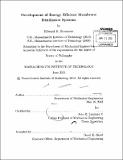Development of energy efficient membrane distillation systems
Author(s)
Summers, Edward K
DownloadFull printable version (12.39Mb)
Alternative title
Development of energy efficient MD systems
Other Contributors
Massachusetts Institute of Technology. Department of Mechanical Engineering.
Advisor
John H. Lienhard, V.
Terms of use
Metadata
Show full item recordAbstract
Membrane distillation (MD) has shown potential as a means of desalination and water purification. As a thermally driven membrane technology which runs at relatively low pressure, which can withstand high salinity feed streams, and which is potentially more resistant to fouling, MD could be used for desalination where reverse osmosis is inadequate. The use of thermal energy, and the ease of construction at small scale, makes this technology attractive for off-grid or renewable power applications as well. However, most research on MD has focused on maximizing purified water output per unit of membrane area as opposed to minimizing system energy consumption and cost. Current MD systems suffer from poor energy efficiency, with reported performance rarely exceeding that of a simple solar still. This thesis explores means to optimize the design of MD for energy efficiency to make it competitive with existing thermal desalination systems, with particular focus on the Air Gap Membrane Distillation (AGMD) configuration. A detailed ID numerical model to explore the effect of design parameters on energy efficiency was developed. Means to enhance energy recovery from hot discharge brine without additional brine concentration, and reduce diffusion resistance by means of reducing pressure in the air gap were explored. A novel configuration delivering solar flux directly to the membrane, and multi-stage, multi-pressure configurations comparable to MSF were also developed. A parameter to relate the performance of a benchscale experiment with similar membrane and gap size to a production system was developed and validated. Small scale experiments were conducted to verify performance for the novel solar powered configuration, reduced gap pressure, and capturing energy from hot discharge brine. Experiments demonstrated the efficacy of a solar absorbing membrane to provide heat to the cycle, and established a benefit of deforming the membrane into the gap under hydraulic pressure; reducing gap size and measurably improving performance. Parametric studies have shown the effectiveness of using the model to design larger, more practical, competitive systems; establishing the importance of long flow lengths, low mean membrane flux, and large membrane area in the design of efficient MD systems.
Description
Thesis (Ph. D.)--Massachusetts Institute of Technology, Dept. of Mechanical Engineering, 2013. Cataloged from PDF version of thesis. Includes bibliographical references (pages 133-137).
Date issued
2013Department
Massachusetts Institute of Technology. Department of Mechanical EngineeringPublisher
Massachusetts Institute of Technology
Keywords
Mechanical Engineering.